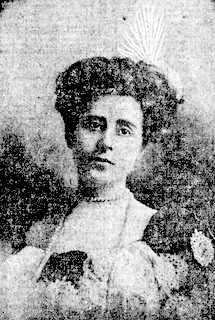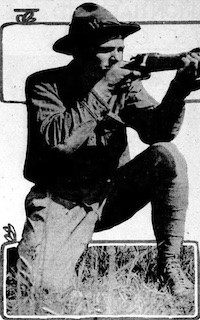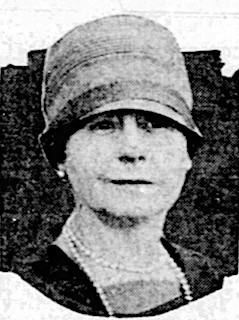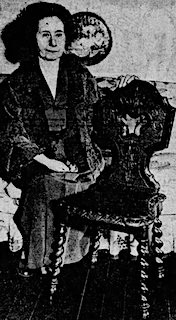Leonora S. Raines, 1866 – 1952

Leonora Raines, née Sheehan was born in 1866 to Cornelius James Sheehan and Elizabeth McCarty Sheehan, who raised their nine children in Atlanta, Georgia. Leonora married accountant Robert H. Raines, whom she divorced in 1904, but whose last name she retained throughout her life (newspaper accounts referred to her at Mrs. Leonora Raines till she died).
Leonora established herself in Paris sometime around 1900 where she was a member of the Girls’ Art Club, making daily visits for the afternoon teas and discussions. She became the society editor of the American Register, founded in 1868 as the first American newspaper in Paris. She left the Register in early 1903 when she joined the staff of the New York Sun at the end of 1902.
Throughout her lengthy Parisian residency (c. 32 years), Raines never lost touch with her home town and family members, whom she visited on a regular basis and hosted when they came to Paris. At different moments between 1900 and 1913, she lived with one of her sisters, who earned a significant reputation for her opera performances in Florence and Paris under the stage name of Signorina Margaret Claire. The two hosted musical and literary salons in their home for the American colony. Margaret married in 1914 and seemingly ended her performing career.
Even though she did not have training in journalism, Leonora began her career as a reporter and opinion writer in Paris, commenting, like a self-styled ethnographer on fashion, art, music, and society. She contributed to numerous American magazines and newspapers, including the Sun (1902-c. 1918) and her hometown newspaper, the Atlanta Journal. Her column, “Art and Music,” in the Journal provided long descriptions of the musical and visual art scene in the U.S. and Europe at the turn of the century. In the early years, she also wrote about American student life in Paris, with special emphasis on women artists and the academies to which they flocked, lauding their hard work and bemoaning their oft-bereft existence:
In the Latin quarter, the truly hard workers live – men and women who have made sacrifices for a year’s study abroad, and who go there and slave from morning till night. They accomplish more than the others, but to the detriment of their health in many instances, and their work bears more the mark of strength than of beauty. [...] But it is a pity to see some of our American brothers and sisters as they walk to and from their studios. Some of them are so poverty-stricken, and indeed it often happens that collections are made among the American colony to send some poor girls home, as they are literally dying of starvation (Atlanta Journal, March 24, 1900, p. 12).
Yet, she still believed that the experience was worth the effort:
It is furthest from my thought to attempt to discourage travel or to decry Paris. After a student has arrived at the point where he can produce form with some facility, there is probably no place in the world where his ideas will get such a thorough shaking up as in Paris. A year there will be of great value. The salons, the Louvre, and the Luxembourg will mean something, and have much to do with broadening his horizons and developing his personality (Atlanta Journal, May 19, 1900, p.13).
Her somewhat ironic description of the selection process for the Parisian salons is worth quoting:
After a picture is finished, recommendation has first to be passed by the teacher, then by an army of judges who mercilessly fling aside anything that does not come up to the standard. After the picture has been admitted by these august personages, however, it has yet to pass a higher tribunal of pastmasters of the brush, and if there be the slightest flaw or objection, then the painting or sculpture is refused (The Atlanta Journal, July 26, 1903, p. 23).

With the outbreak of WWI, Leonora made her reputation as war correspondent for the New York Sun, providing “first-hand observations of belligerent troops” and revealing “how civilians across Western Europe were struggling to cope with loss, despair, and uprooted lives” (Journalism History). Becoming a wartime correspondent had not necessarily been part of her plans or those of the Sun:
Even as the Germans crossed into Belgium and took Paris for their goal, she had no thought of turning war correspondent. Like other Americans, she packed her trunks, and, when the fall of Paris seemed a matter of days, she sought transportation to the ports. But what chance was there? With her trunks round her, she sat disconsolately at the station and saw 2,000 people struggling and fighting for passage through the narrow gates to the trains. For a woman all alone to force a way through that crowd was impossible. “Well,” decided Mrs. Raines, “since I can’t go I’ll stay and write what I see.” [...] she set out to find the war; and not once but many times she almost reached the battleline. Until the soldiers stopped her, she would penetrate right into the fighting district. Her course would lie over fields where Germans, French and English had struggled, and the picture of carnage would stretch before her eyes (Atlanta Journal, November 22, 1914, p. 29).
Putting her heart and soul into her reporting, Leonora wrote long articles about the soldiers, the battlefronts, the trenches (which she termed a “double line of slaughter pens” (Atlanta Journal, January 17, 1915, p.38), mingling her observations and experiences with opinions about the war, the Germans, and Allied propaganda campaigns. Her writings appeared not only in the Sun but were often reprinted or quoted in the Atlanta Journal and other U.S. newspapers. She spent months on foot, in camionettes, coal vans, or river boats, scalded by a hot sun or drenched by rain, encountering shattered bodies and utter devastation. After sending dispatches from France, Germany, Switzerland, and Belgium, she returned to Paris. Finding the city dark and gloomy, she longed for home: “After all I have seen, Atlanta is two-fold dear to me” (Atlanta Journal, January 15, 1916). She sailed to the U.S. in December 1915, but returned to Paris in March 1916, where she mainly resumed writing about lighter subjects such as music, fashion, soldier types, French women, and American women.

She regained Atlanta after the Armistice, where she gave speeches on comparisons between the U.S. and Europe, wrote about jazz and music from the south (not without the harsh stereotypes typical of her day). In 1923, she went back to a-much transformed Paris, save for the weather: “I lived in the rain. I left in the rain, I return in the rain, and the rain I have ever with me” (“Where is the Paris of Yesteryear?”). Besides regularly sailing to the U.S., where she visited with family in Atlanta and toured Florida (1926), she traveled to Italy, North and Sub-Saharan Africa, Spain, Majorca, and Cuba, among other destinations.
Her thirst for travel continued for many years; even after her return to Atlanta in 1932, she traveled throughout the U.S. and made a world tour in 1934, visiting China, Japan, India returning after fourteen months via Honolulu and the Panama Canal. She left again for an extensive tour of continental Europe in 1937 and a three-month trip to Greece, Turkey, Italy, Austria, Germany, and Belgium in 1939. All the while, she continued to write articles that were as varied as her lifestyle, filled with commentaries on the places she visited and people she met, replete with comparisons and thoughts about America and Europe, and the beauty of the natural world (trees, gardens, parks).
With the onset of WWII, her greatest fear was that the U.S. would once again come to the assistance of Europe. She asserted rather controversial ideas with the ease of someone who felt entitled by the knowledge she had garnered through her travels and experiences in the “Great War”:
The Allies realized how we reacted to the horrors of war, so they fed horrors to us. Europeans are accustomed to war and take it in its stride. They always have had wars and will probably continue to have them after this one. [...] We should remain aloof and let European nations fight European battles. We have no business in any war over there. Let them fight it out among themselves (Atlanta Journal, May 22, 1940, p. 16).
I lingered long on those lands and absorbed something of their philosophy, their psychology, their point of view. Consequently, I am quite unmoved at their pleas for forthrightness, democracy, fair play. In a word, knowing them as I do has made a deep-rooted isolationist of me (Atlanta Journal, January 14, 1941, p. 14).

Leonora Sheehan Raines lived out the remainder of her existence mainly in Atlanta, where she gave speeches and wrote letters to the editor of the Atlanta Journal – ever the opinionated and outspoken analyst. True to her varied interests, she wrote and spoke about the memorable sites she had visited, the history of Atlanta, music, the newspaper industry, landscapes and cityscapes, immigration, books, and the like. A patron of the arts, she funded prizes for art students and donated paintings and furniture to the High Museum.
She died on Wednesday, June 25, 1952 and was buried in the Oakland Cemetery, where, as she foretold, history left her behind: “[...] a huge, far-spreading tablet that will record where the city’s fathers and forefathers sleep, and will commemorate the lives of those that have passed to silent dust” (The Atlanta Journal, January 7, 1906, p. 26).